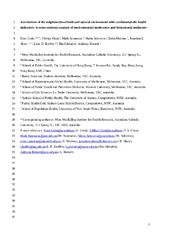| dc.contributor.author | Cerin, Ester | |
| dc.contributor.author | Barnett, Anthony | |
| dc.contributor.author | Wu, Yu-Tzu | |
| dc.contributor.author | Martino, Erika | |
| dc.contributor.author | Shaw, Jonathan E. | |
| dc.contributor.author | Knibbs, Luke D. | |
| dc.contributor.author | Poudel, Govinda | |
| dc.contributor.author | Jalaludin, Bin | |
| dc.contributor.author | Anstey, Kaarin J. | |
| dc.date.accessioned | 2023-12-29T10:43:37Z | |
| dc.date.available | 2023-12-29T10:43:37Z | |
| dc.date.issued | 2023-11-08 | |
| dc.description.abstract | Characteristics of the neighbourhood environment, including the built and natural environment, area-level socio-economic status (SES) and air pollution, have been linked to cognitive health. However, most studies have focused on single neighbourhood characteristics and have not considered the extent to which the effects of environmental factors may interact. We examined the associations of measures of the neighbourhood built and natural environment, area-level SES and traffic-related air pollution (TRAP) with two cognitive function domains (memory and processing speed), and the extent to which area-level SES and TRAP moderated the associations.<p>
<p>We used cross-sectional data from the AusDiab3 study, an Australian cohort study of adults (mean age: 61 years) in 2011–12 (N = 4141) for which geocoded residential addresses were available. Spatial data were used to create composite indices of built environment complexity (population density, intersection density, non-commercial land use mix, commercial land use) and natural environment (parkland and blue spaces). Area-level SES was obtained from national census indices and TRAP was based on estimates of annual average levels of nitrogen dioxide (NO2). Confounder-adjusted generalised additive mixed models were used to estimate the independent associations of the environmental measures with cognitive function and the moderating effects of area-level SES and TRAP. The positive associations between built environment complexity and memory were stronger in those living in areas with higher SES and lower NO2 concentrations. A positive association between the natural environment and memory was found only in those living in areas with lower NO2 concentrations and average or below-average SES. Built environment complexity and the natural environment were positively related to processing speed. Complex urban environments and access to nature may benefit cognitive health in ageing populations. For higher-order cognitive abilities, such as memory, these positive effects may be stronger in areas with lower levels of TRAP. | en_US |
| dc.identifier.citation | Cerin E, Barnett, Wu, Martino, Shaw, Knibbs, Poudel, Jalaludin, Anstey. Do neighbourhood traffic-related air pollution and socio-economic status moderate the associations of the neighbourhood physical environment with cognitive function? Findings from the AusDiab study. Science of the Total Environment. 2023;858 | |
| dc.identifier.cristinID | FRIDAID 2132020 | |
| dc.identifier.doi | 10.1016/j.scitotenv.2022.160028 | |
| dc.identifier.issn | 0048-9697 | |
| dc.identifier.issn | 1879-1026 | |
| dc.identifier.uri | https://hdl.handle.net/10037/32268 | |
| dc.language.iso | eng | en_US |
| dc.publisher | Elsevier | en_US |
| dc.relation.journal | Science of the Total Environment | |
| dc.rights.holder | Copyright 2023 The Author(s) | en_US |
| dc.title | Do neighbourhood traffic-related air pollution and socio-economic status moderate the associations of the neighbourhood physical environment with cognitive function? Findings from the AusDiab study | en_US |
| dc.type.version | acceptedVersion | en_US |
| dc.type | Journal article | en_US |
| dc.type | Tidsskriftartikkel | en_US |
| dc.type | Peer reviewed | en_US |


 English
English norsk
norsk